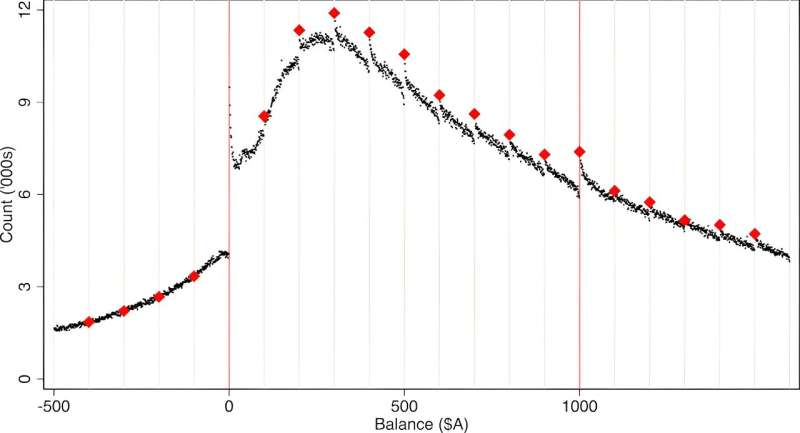
September 30, 2024 by Robert Breunig, The Conversation
Collected at: https://phys.org/news/2024-09-rounding-tax-evasion.html
Australia’s tax system is needlessly complex, and that’s making it costly in ways that aren’t obvious.
New research from our team at the Australian National University’s Tax and Transfer Policy Institute, in the Journal of Public Economics, has identified one of the unexpected ways it is wasting our time, and found pretty clear evidence of tax evasion along the way—evidence the Tax Office will be able to use.
Here’s what we did.
Examining 27 years of de-identified individual tax files, we noticed a striking number of returns generating “round number” refunds.
By “round number,” I mean refunds whose last digit is zero.
Zeros are exceptionally popular
We found, for instance, far more refunds of exactly $1,000 than of $999 or $995, or even $1,005 or $1,015.
This phenomenon was particularly striking at zero (many fewer people got refunds of slightly less than zero, which would have meant they owed money) and also apparent at tens and hundreds as well as thousands.
Analyzing what the returns with round numbers had in common, we found they were more likely than other returns to be
- driven by efforts to evade and minimize tax rather than simply earn income
- driven by things that are costly for the Tax Office to audit (such as work-related expense deductions).
- prepared by agents (zeros were twice as common in agent-prepared returns)
Next, we matched our data about zeros with data from the Tax Office’s random audit program. We found that, when audited, returns with round number refunds were significantly more likely to be wrong. Specifically, they were more likely to overstate the refund that was owed.
More than a quirky preference
This suggests round number refunds are not just a quirky preference—they signal something going on, most likely something going wrong.
That “something” seems to be the manipulation of claims that are costly to verify, principally work-related expense deductions and business income.
Expense deductions and business income are significantly larger in returns with round number refunds than in those without.
It is important to note we found some tax agents got round number returns a lot while others did it very little or not at all.
More like evasion than planning
When taxpayers switch from “low-rounding” to “high-rounding” agents, we see a one-off hike in the returns those people receive, with no further increases thereafter.
This is likely to mean that agents who specialize in round-number returns are not working with their clients over time to rearrange their affairs to minimize tax or to better document legitimate deductions.
Were that the case, we would see the value of these returns increase over time.
This makes the behavior of these agents more consistent with tax evasion than tax planning.
We can fight it, or use it as a tool
One simple response to this abuse would be to remove many of the deductions and lower tax rates for everyone.
Another would be to copy the United States and offer all taxpayers a large “standard deduction,” inviting only those that want a larger one to go to the effort of itemizing their claims. (The US standard deduction is currently US$14,600 for singles and US$29,200 for couples filing jointly.)
In the meantime, the Tax Office might be able to put our findings to good use.
It could identify the clients the agents who get round number returns as targets for audits. They are more likely than others to be improperly claiming.
In the longer term, this strategy won’t work as well. The agents who have been delivering round number returns will become aware that their clients are being targeted and change their behavior.
This means that after a while nothing will work as well as tax reform. It would save taxpayers time and make the system more fair for everyone.
More information: Robert Breunig et al, Rounded Up: Using round numbers to identify tax evasion, Journal of Public Economics (2024). DOI: 10.1016/j.jpubeco.2024.105195
Journal information: Journal of Public Economics

Leave a Reply